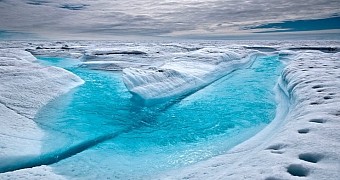Evidence at hand indicates that the Greenland Ice Sheet is way more vulnerable to climate change and global warming than previously assumed, researchers argue in a paper published in the journal Nature Communications this September 29.
Were the Greenland Sheet about the size of a couple dozen ice cubes all lined up in a tray, chances are that this paper would have gone unnoticed. Unfortunately, this is not the case.
Thus, the Greenland Ice Sheet is estimated to cover an area of about 1.7 million square kilometers (about 0.65 million square miles), which is the equivalent of roughly 8 times the size of the UK.
In fact, this sheet is argued to be the second-largest block of ice of this kind in the world. As explained in the journal Nature Communications, this makes it a major contributor to global sea level rise.
Evidence obtained during previous investigations indicates that, each and every year, the Greenland Sheet loses about 200 gigatonnes of ice due to surface melting alone. This loss translates into a sea level rise of 0.6 millimeters (about 0.02 inches).
The problem is that, according to specialists with the University of Cambridge, surface melting is not the only phenomenon currently reshaping the Greenland Ice Sheet. On the contrary, ice flow also has a say in the matter.
An ice sheet's daily routine
The University of Cambridge scientists behind this research project and their colleagues say that, hoping to figure out what the future has in store for the Greenland Ice Sheet, they put together and analyzed several computer models concerning melt patterns.
It was thus discovered that lakes that form on its surface during the melt season can release their water through crevices all the way down to the ground that the sheet is resting on. All this water softens the land, and causes the Greenland Ice Sheet to pick up speed when on its way towards the ocean.
“The soft sediment gets weaker as it tries to soak up more water, making it less resistant, so that the ice above moves faster. The Greenland Ice Sheet is not nearly as stable as we think,” said researcher Poul Christoffersen with Aberystwyth University.
“Not only is the ice sheet sensitive to a changing climate, but extreme meteorological events, such as heavy rainfall and heat waves, can also have a large effect on the rate of ice loss,” the specialist went on to explain, as cited by EurekAlert.
Why should we care about this ice sheet?
Admittedly, the Greenland Ice Sheet does not all that often come up in casual conversation. Still, this does not change the fact that we should pay close attention to what is happening to it, and worry about how climate change and global warming are transforming it.
This is because, according to several estimates, this ice sheet stands to push global sea levels up by an impressive 7 meters (approximately 23 feet), were it to melt in its entirety. In all fairness, the chances that we will lose the Greenland Ice Sheet by the end of this century are slim to none.
However, specialists warn that, the more global temperatures increase, the more this block of ice will melt and the faster it will travel towards the ocean. This means that the Greenland Ice Sheet stands to become a major contributor to sea level rise, a phenomenon that constitutes a threat to coastal communities worldwide.

 14 DAY TRIAL //
14 DAY TRIAL //